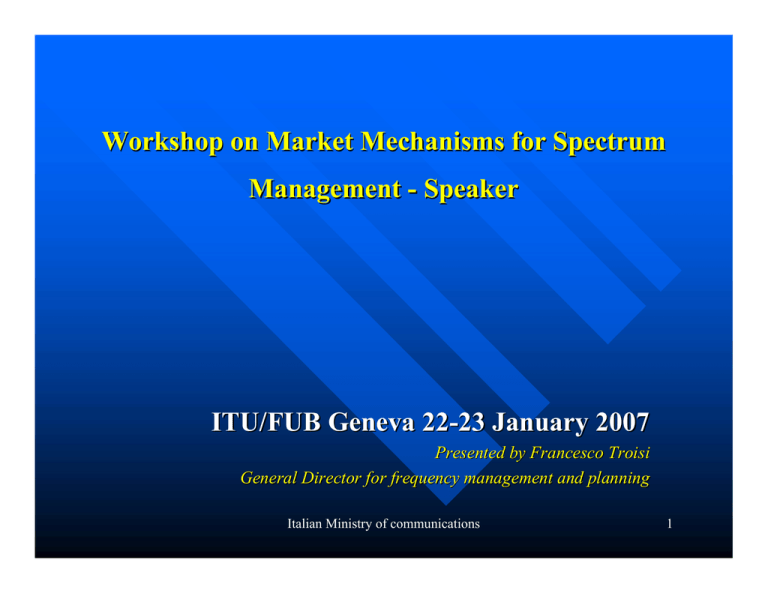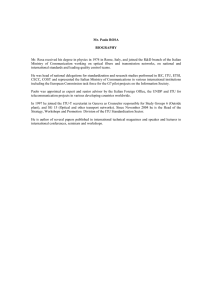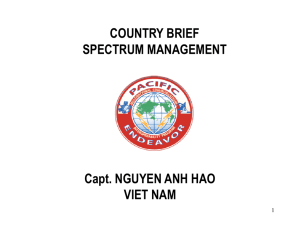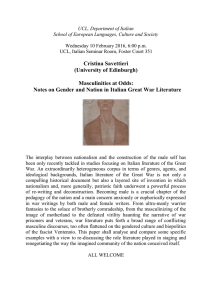Workshop on Market Mechanisms for Spectrum Management - Speaker
advertisement

Workshop on Market Mechanisms for Spectrum Management - Speaker ITU/FUB Geneva 22-23 January 2007 Presented by Francesco Troisi General Director for frequency management and planning Italian Ministry of communications 1 Italian way in spectrum management and planning The bodies involved in Italy in the spectrum management and planning are: Ministry of communication entitled for spectrum allocation and for private and public services frequency assignment for civil utilisation and for the elaboration of the assignment plans apart of broadcasting services Ministry of defence entitled of the management of frequencies for military and public safety applications Authority of telecommunications entitled of frequency planning for broadcasting services Italian Ministry of communications 2 Italian way in spectrum management and planning The main tool for manage the frequencies allocation is the Piano Nazionale di Ripartizione delle Frequenze (PNRF) The PNRF is a Ministerial Decree that is fully updated every three years and in particular after the conclusion of a WRC The procedure of a partial or complete updating of the PNRF is performed through a previous consultation with all the parties interested in the frequency utilisation Italian Ministry of communications 3 Main issues related to the spectrum management in Italy Participation to the international fora Coordination with neighbouring countries Market surveillance to grant that the apparatus are fit to meet the scope of using the spectrum in an efficient way Spectrum monitoring to grant that every operator, entitled of a frequency right of use, will use the resource under the conditions stated by authorisations Italian Ministry of communications 4 Main issues related to the spectrum management in Italy The Ministry of communications performs both market surveillance and spectrum monitoring trough a network of local offices, equipped with mobile and fixed measurement laboratories. The monitoring stations are located at every Italian regione and are also present at provincial level. Italian Ministry of communications 5 Reason of growing interest for wireless communications The utilisation of the radio spectrum as became, in the very last decades, more and more important, due to: the current development of the electronic communications prevalently toward the wireless links in alternative to the wired ones the complexity and the cost of the deployment of the wired local loop that make ever more fit the wireless lines The result of the ever growing request of spectrum is a great pressure on spectrum managers to have new bands available for new services and to introduce new technologies more efficient in spectrum utilisation. Italian Ministry of communications 6 It needs a new way for spectrum management? there is pressure for more flexibility both in the assignment of new resource and in the market of frequencies at European level, both in CEPT and in European Commission, is now in discussion a new approach to the frequency management Italian Ministry of communications 7 Request for flexibility in frequency allocation: main issues search for frequency bands that can be not subject to any kind of a priori allocation, free to be used without any kind of harmonization technological neutrality: no advantages must be given to a particular technology in frequency allocation Italian Ministry of communications 8 An obvious (?) consideration spectrum is a scarce and easily polluted resource What this means? the need for a cautious use of frequencies, based in an international set of rules aiming to prevent incorrect use of the resources the harmonisation is a practice useful for both the final users and the manufacturers Italian Ministry of communications 9 What the real problem is? what is the extend of regulation to be settled in order to avoid unnecessary constrains on the development of new applications the amount of harmonization really necessary to grant the users and the manufactures and contemporary to avoid the exclusion from the market of new and more efficient technologies Italian Ministry of communications 10 A look from the point of view of the user independently of is technical skill ness, the user needs to access in the simplest way the information networks, without the need to retune or change its terminal while travelling from a national network to another: in few words interoperability at the higher level possible Italian Ministry of communications 11 A look from the point of view of manufacturers and operators to have a market as huge as possible, and this can be obtained only with an economy of scale able to widen the market for a terminal or an application Italian Ministry of communications 12 Harmonization or liberalisation? harmonization of the frequency at most wide level attainable but not exceeding the minimum need to grant interoperability and economy of scale liberalisation at level necessary to let the way open to the introduction, without excessive and not necessary restrictions, to new innovative technologies Italian Ministry of communications 13 How the balance can be performed? to seek for application whose utilization is not subject to any kind of authorisation ex ante: existing SRD applications, planned UWB applications to reach a certain amount of flexibility also for other applications, but granting the degree of commonality necessary to maintain the minimum of interoperability between different applications recognised as member of a specific family of service, and to assure to the manufacturers that he can face not a number of different markets with different standards and frequencies , but an unique great market which benefit of the economy of scale Italian Ministry of communications 14 A look to a hypothetic, more o less distant, future when it will be possible to tune the terminal by software, in a large bandwidth, and harmonize only a common channel to download from the network the information about the service offered, the frequencies used and the characteristic of the service, then it will be possible to stop with harmonization of the frequencies and of the standard preserving the possibility of the interoperability and of the mass production of terminals with the advantages of economy of scale Italian Ministry of communications 15







